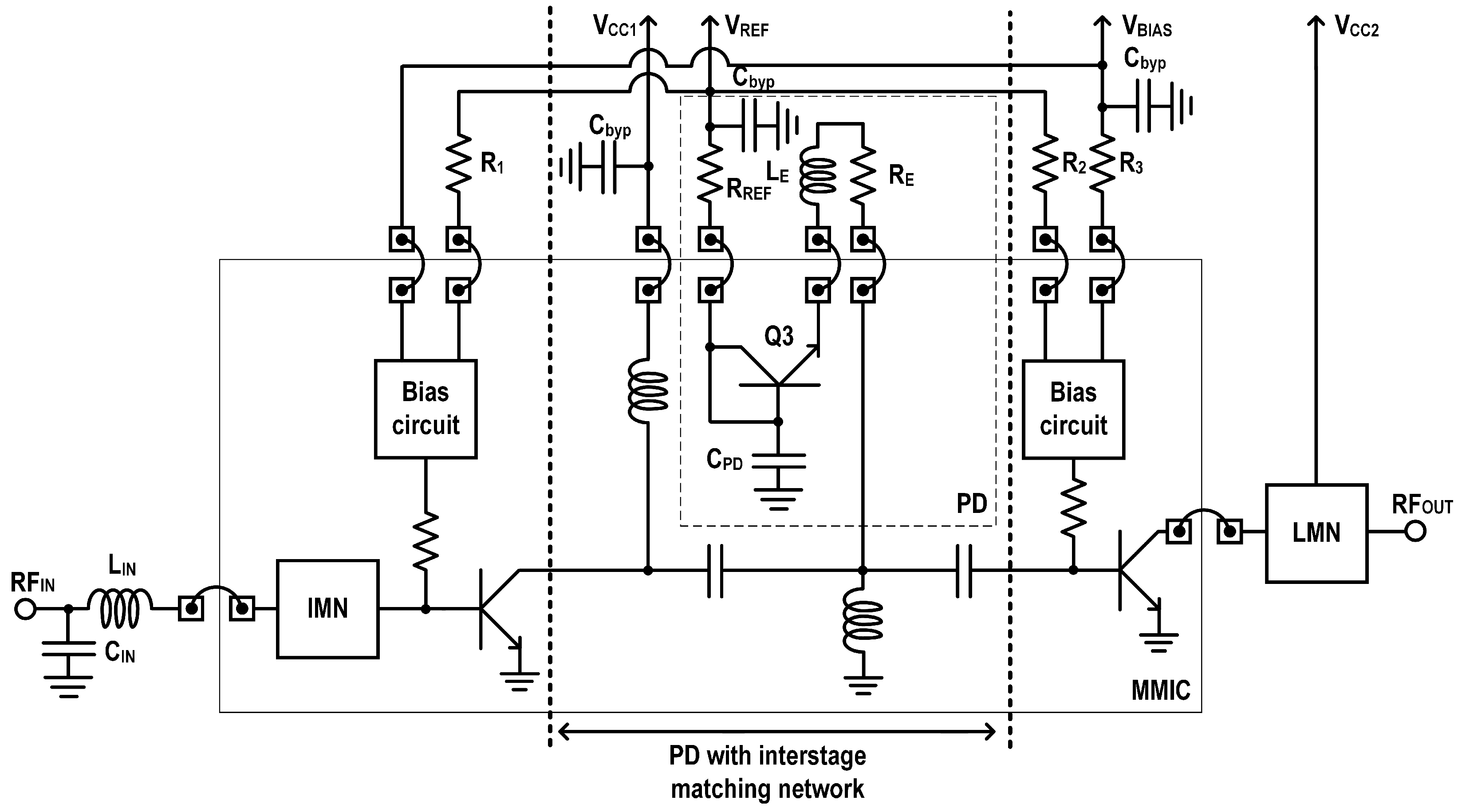Highly Linear 2.6 GHz Band InGaP/GaAs HBT Power Amplifier IC Using a Dynamic Predistorter
Abstract
1. Introduction
2. Design of the Dynamic Predistorter
2.1. Circuit Configuration
2.2. Dynamic Compensation of Nonlinearities
3. Implementation and Measurement Results
4. Conclusions
Author Contributions
Funding
Data Availability Statement
Conflicts of Interest
References
- Kim, C.; Jee, S.; Jo, G.; Lee, K.; Kim, B. A 2.14-GHz GaN MMIC Doherty power amplifier for small-cell base stations. IEEE Microw. Wireless Compon. Lett. 2014, 24, 263–265. [Google Scholar] [CrossRef]
- Jiang, T.; Yang, Y.; Song, Y.-H. Exponential companding transform for PAPR reduction in OFDM systems. IEEE Trans. Broadcast. 2005, 51, 244–248. [Google Scholar] [CrossRef]
- Choi, K.; Kim, M.; Kim, H.; Jung, S.; Cho, J.; Yoo, S. A highly linear two-stage amplifier integrated circuit using InGaP/GaAs HBT. IEEE J. Solid-State Circuits 2010, 45, 2038–2043. [Google Scholar] [CrossRef]
- Yang, Y.; Choi, K.; Weller, K.P. DC boosting effect of active bias circuits and its optimization for class-AB InGaP-GaAs HBT power amplifiers. IEEE Trans. Microw. Theory Tech. 2004, 52, 1455–1463. [Google Scholar] [CrossRef]
- Pipilos, S.; Papananos, Y.; Naskas, N.; Zervakis, M.; Jongsma, J.; Gschier, T. A transmitter IC for TETRA systems based on a Cartesian feedback loop linearization technique. IEEE J. Solid-State Circuits 2005, 40, 707–718. [Google Scholar] [CrossRef]
- Yang, Y.; Woo, Y.Y.; Kim, B. Optimization for error-canceling loop of the feedforward amplifier using a new system-level mathematical model. IEEE Trans. Microw. Theory Techn. 2003, 51, 475–482. [Google Scholar] [CrossRef]
- Yamauchi, K.; Mori, K.; Nakayama, M.; Mitsui, Y.; Takagi, T. A microwave miniaturized linearizer using a parallel diode with a bias feed resistance. IEEE Trans. Microw. Theory Techn. 1997, 45, 2431–2435. [Google Scholar] [CrossRef]
- Li, W.; Shen, C.; Wang, S. A 2.6 GHz RF power amplifier with 25.6 dBm linear power and –47 dBc ACLR for small-cell applications. In Proceedings of the 2017 IEEE MTT-S International Microwave Symposium (IMS), Honololu, HI, USA, 4–9 June 2017; pp. 627–629. [Google Scholar]
- Seo, M.; Kim, K.; Kim, M.; Kim, H.; Jeon, J.; Park, M. Ultrabroadband Linear Power Amplifier Using a Frequency-Selective Analog Predistorter. IEEE Trans. Circuits Syst. II Exp. Briefs 2011, 58, 264–268. [Google Scholar] [CrossRef]
- Noh, Y.; Park, C. PCS/W-CDMA dual-band MMIC power amplifier with a newly proposed linearizing bias circuit. IEEE J. Solid-State Circuits 2002, 2, 1096–1099. [Google Scholar]
- Jagadheswaran, U.; Ramiah, H.; Mak, P.; Martins, R.P. A 2-μm InGaP/GaAs Class-J Power Amplifier for Multi-Band LTE Achieving 35.8-dB Gain, 40.5% to 55.8% PAE and 28-dBm Linear Output Power. IEEE Trans. Microw. Theory Techn. 2016, 64, 200–209. [Google Scholar] [CrossRef]
- Liu, M.; Ma, Z.; Ma, K.; Fu, H. A High-Power GaAs Amplifier with Coupled BondingWires-Based Harmonic Control Output Matching Network. IEEE Microw. Wireless Technol. Lett. 2023, 33, 1305–1308. [Google Scholar] [CrossRef]
- Bae, S.; Jeon, J.; Hwang, S.; Yoon, B.; Kim, J. A Highly Linear and Efficient Differential Power Amplifier with 35-dBm Saturated Output Power, 65% Peak PAE by Reducing Base Voltage Peaking in InGaP/GaAs HBT Process for Handset Applications. In Proceedings of the 2024 IEEE/MTT-S International Microwave Symposium-IMS 2024, Washington, DC, USA, 16–21 June 2024; pp. 374–377. [Google Scholar]









| Ref. | Freq. (GHz) | Ppeak (dBm) | Modulated Signal | PAPR (dB) | ACLR (dBc) | Pavg (dBm) | OBO (dB) | PAEavg (%) |
|---|---|---|---|---|---|---|---|---|
| [8] | 2.6 | 32.14 | LTE 20M | - | −47 | 25.6 | 6.5 | 17.2 |
| [11] | 1.7–2.05 | 31 | LTE 20M | 7.88 | −30 | 28 | 3 | 40 |
| [12] | 2.3–2.6 | 32.8 | 64-QAM 20M | 6.1 | −33.2 | 16.4 | 16.4 | 5 * |
| [13] | 2.3–2.7 | 35 | NR 20M | 10.83 | −34 | 28–29 | 6–7 | 27 |
| This work | 2.5–2.7 | 35 | NR 100M | 9.7 | −40 | 24 | 11 | 11.8 |
Disclaimer/Publisher’s Note: The statements, opinions and data contained in all publications are solely those of the individual author(s) and contributor(s) and not of MDPI and/or the editor(s). MDPI and/or the editor(s) disclaim responsibility for any injury to people or property resulting from any ideas, methods, instructions or products referred to in the content. |
© 2025 by the authors. Licensee MDPI, Basel, Switzerland. This article is an open access article distributed under the terms and conditions of the Creative Commons Attribution (CC BY) license (https://creativecommons.org/licenses/by/4.0/).
Share and Cite
Jeon, H.; Shin, J.; Choi, W.; Bae, S.; Bae, K.; Bin, S.; Kim, S.; Ju, Y.; Ahn, M.; Mun, G.; et al. Highly Linear 2.6 GHz Band InGaP/GaAs HBT Power Amplifier IC Using a Dynamic Predistorter. Electronics 2025, 14, 2300. https://doi.org/10.3390/electronics14112300
Jeon H, Shin J, Choi W, Bae S, Bae K, Bin S, Kim S, Ju Y, Ahn M, Mun G, et al. Highly Linear 2.6 GHz Band InGaP/GaAs HBT Power Amplifier IC Using a Dynamic Predistorter. Electronics. 2025; 14(11):2300. https://doi.org/10.3390/electronics14112300
Chicago/Turabian StyleJeon, Hyeongjin, Jaekyung Shin, Woojin Choi, Sooncheol Bae, Kyungdong Bae, Soohyun Bin, Sangyeop Kim, Yunhyung Ju, Minseok Ahn, Gyuhyeon Mun, and et al. 2025. "Highly Linear 2.6 GHz Band InGaP/GaAs HBT Power Amplifier IC Using a Dynamic Predistorter" Electronics 14, no. 11: 2300. https://doi.org/10.3390/electronics14112300
APA StyleJeon, H., Shin, J., Choi, W., Bae, S., Bae, K., Bin, S., Kim, S., Ju, Y., Ahn, M., Mun, G., Hwang, K. C., Lee, K.-Y., & Yang, Y. (2025). Highly Linear 2.6 GHz Band InGaP/GaAs HBT Power Amplifier IC Using a Dynamic Predistorter. Electronics, 14(11), 2300. https://doi.org/10.3390/electronics14112300







